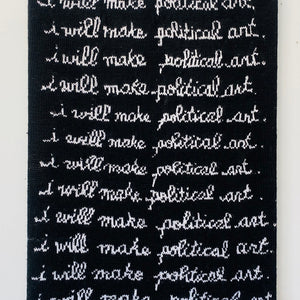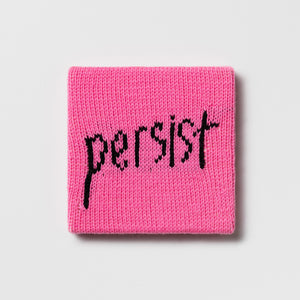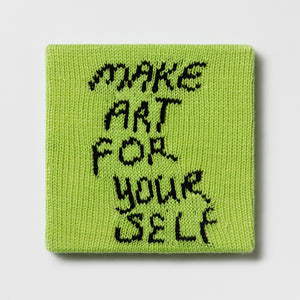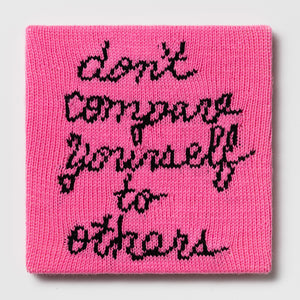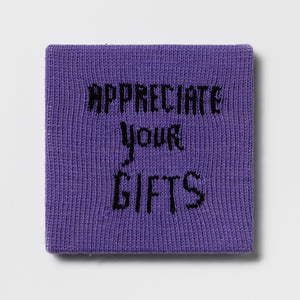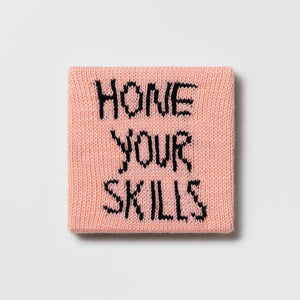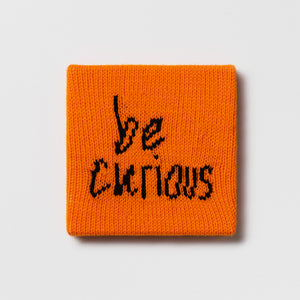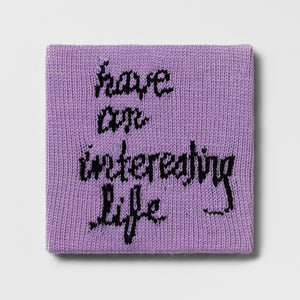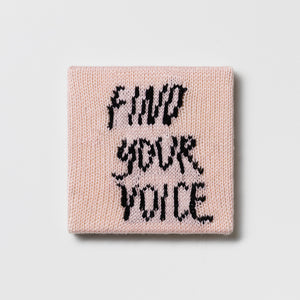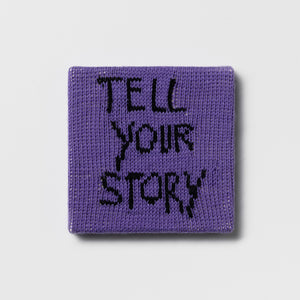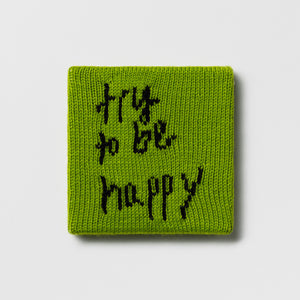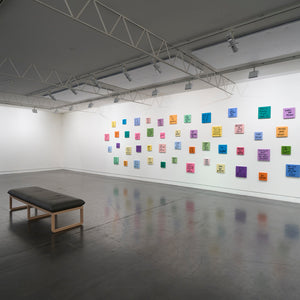Kate Just 50 RULES FOR MAKING ART
23 May to 22 June 2024
50 Rules for Making Art
'50 Rules for Making Art' opens two weeks before my 50th birthday. Like many artists, I consider myself to have been making art all my life. The show was inspired by my love of ‘rules’ for making art written by artists including Corita Kent, John Baldessari, Sol Lewitt and art critic Jerry Saltz. My love of rules connects to my ordered nature, my penchant for seriality and my belief that rules offer structure, but also freedom to deviate from expectation.
Central to this exhibition is the series of fifty hand knitted square panels in three different sizes. Created in a palette and shape that refers to brightly coloured post-it-notes, each square bears a ‘rule’ for making art that has informed my life and practice. To produce the works, I printed knitting grids, and hand drew each text upon the grid, so it bore the scrawl of my own handwriting. I then hand knitted each stitch corresponding to the grid, marking each row as I went. I shared each finished piece on social media, along with a detailed text explaining what the rule means to me.
Spread out in the gallery like a wall of affirmative ‘notes to self,’ the knitted collection of ‘50 Rules for Making Art’ addresses the financial and personal precarity of making art, the reality of rejection, the courage and risk required to be an artist and the passion, joy and curiosity of a life lived in art. The knitted rules include: ‘Make Time For Art’, ‘Get Used To Rejection’, ‘Have Fun’, ‘Let Art Teach You How To Live’, ‘Don’t Listen To Your Inner Critic’, ‘Break All the Rules’, ‘Choose Subjects That Matter To You’, and ‘The Personal Is Political’. When knitting the texts, I thought about generations of women before me who had knitted samplers for the home, bearing phrases such as ‘Home Sweet Home’ or ‘Home is Where the Heart Is.’ I reflected on the ways, throughout my art career, that I have used to knitting to challenge and reshape notions of craft as a ‘domestic’ art. Through knitted works, I draw attention to the ways women’s (art)work has been devalued. My work posits that knitting and other craft forms are as important as painting.
The fifty knitted rules and their accompanying narratives are also documented in the book ‘50 Rules for Making Art’. In the introduction to the book, I share: ‘While knitting, I reflected on the number of years I’ve lived and the many lessons I’ve learned about making art. This work is dedicated to my students and all the artists out there who are still working out how to make a life in art.’ As an artist and a teacher, I often see students struggling with the limits and expectations they put upon themselves. I wanted to remind myself and newer artists that we can make our own rules about making art that are nurturing, guiding, and freeing, rather than restrictive and oppressive.
There are five additional works in the show, that further test and examine ideas about the art world and artists. Three works pay homage to historical artworks. Dearest Art Collector, is a large scale hand knitted homage to the Guerrilla Girls 1986 screen-print work of the same name. The Guerrilla Girl’s original work comprises a handwritten letter on pink paper that states: ‘Dearest Art Collector, It has come to our attention that your collection, like most, does not contain enough art by women. We know that you feel terrible about this and will rectify the situation immediately. All our love, Guerrilla Girls.’ This iconic work of feminist art uses humour to challenge the lack of representation of women artists’ works in major collections, and the devaluing of the price of our work in the art market. My laborious hand knitting of this artwork thirty-six years later honours these feminist artists who came before me and reflects on whether significant change has been achieved since 1986.
My large-scale, hand knitted homage to John Baldessari’s acrylic painting TIPS FOR ARTISTS WHO WANT TO SELL (1966-1968), questions notions of craft, time, labour and gender in art. John Baldessari never touched his paintings. The Broad Museum, who hold this painting in their collection state: ‘Baldessari did not paint it. He did not write the text.’ Baldessari sought to prove an artist could make work in one’s head rather than presenting a material object by his own hand. To create TIPS FOR ARTISTS WHO WANT TO SELL, Baldessari paid a signwriter to paint a text from an art trade magazine dictating what art content should be.
My knitting of this well-known work underscores my focus upon hand crafted works that reflect my personal and feminist narratives. The text in Baldessari’s painting is humorous and bears many references to stereotypical expectations of gender. It asserts that Madonna paintings and nudes sell well, confirming the stereotypes of women as objects or religious figures across art history. The text also notes that paintings with cows and hens (female animals) collect dust while the same paintings with bulls and roosters (male versions of the same animals) sell well. By hand knitting this text, I question these gender stereotypes in the original painting, assert the value of craft and material processes as their own form of embodied knowledge, and question the ongoing dichotomies between ‘craft’ and ‘high art’.
My knitted black and white cursive work ‘I will make political art’ also refers to John Baldessari. In 1971, the Nova Scotia College of Art and Design, Halifax, invited John Baldessari to exhibit his work. ‘However, the college did not have the funds for Baldessari to travel to Halifax, so the artist proposed that the art students in Halifax act as his surrogates. The students were instructed by Baldessari to write “I will not make any more boring art” on the gallery walls for the duration of the exhibition (April 1-10, 1971).’ In this and other works, Baldessari made fun of art education, which he believed inspired students to imitate rather than experiment and develop new thinking. My knitted handwritten repeated phrase, ‘I will make political art’ is both a deviation from and a renewal of Baldessari’s intention. Writing lines is usually a punishment issued at school; the repetition is supposed to drill in the correction one is being asked to make to one’s behaviour. I updated Baldessari’s instruction to reflect my commitment to making art with personal and political statements. As a teacher and an artist, I also believe artists have a right and a duty to speak our personal and political truth and reshape the world of art.
The hand knitted work ‘Artists, you do know, don’t you, that your mistakes are your style’ is a knitted homage to a note that famous New York art critic Jerry Saltz scrawled on a legal pad and then shared via his Instagram account @jerrysaltz. A one-time artist who became an art critic, Jerry Saltz loves artists and has written numerous books for or about artists including How To Be An Artist (2020) and Art is Life (2022). The hand knitting of his message took on extra meaning for me as an artist who knits. Knitting is never perfect; there are always tension issues, dropped stitches, and wobbly or wonky parts of the work. In my early years as an artist, I hated these mistakes. I later learned to embrace these mistakes because they reflect the human hand and body (mine) that crafts the work and the impact of daily life, stress, and joy upon my work.
The exhibition ends on the only self-portrait I have every knitted: ‘Self Portrait of the Artist: Everyone can be Pussy Riot.’ This knitted portrait refers to the photograph by Giulia Giannini McGauran taken as my profile picture at the university where I teach. I requested a yellow backdrop for my picture and wore a t-shirt that reads: ‘Everyone can be Pussy Riot’ with a black leather jacket. I posed with a sly smile and held up my FEMINIST coffee cup. The knitting of this portrait reflects on the ways I counter institutional rigidity with my personal politics. It also references my Feminist Fan series of 2015-2017, in which I hand knitted over forty pictures of my favourite queer and feminist art icons, many of whom incorporate, craft, textile and fashion and their socially and politically engaged art. This portrait of me celebrates my 50th birthday, my 50 years of making art and my belief that at every age, artists can be true to ourselves and a force for change.
On the last page of my book, I signed off, Have Fun! I love you for making art! (I do!)- Kate Just, 2024
___________________________________________________________________
The accompanying exhibition catalogue publication is available to purchase through the Hugo Michell Gallery Online Shop here.
Enquiries to mail@hugomichellgallery.com





